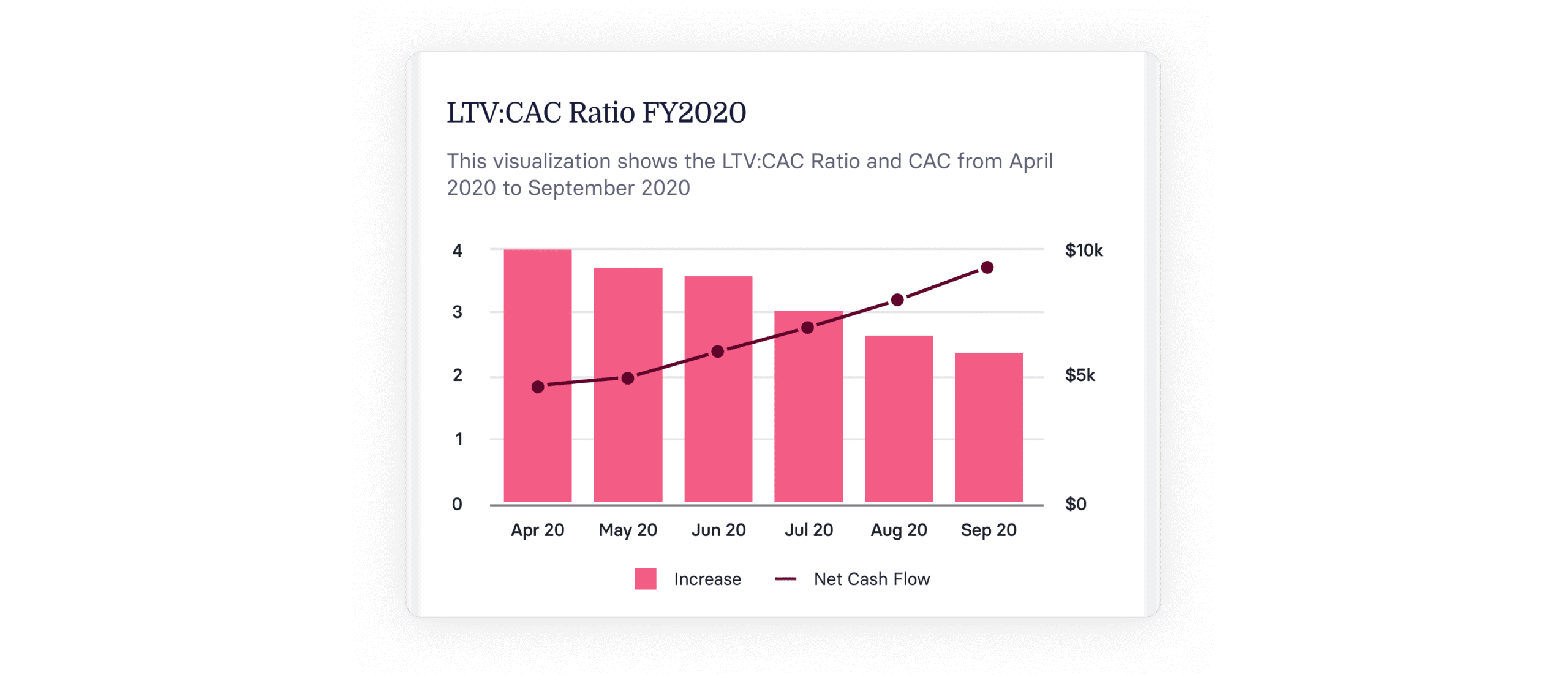The LTV to CAC ratio is vital for SaaS businesses, revealing the balance between customer lifetime value and the cost of acquiring customers.
What is LTV/CAC?
The LTV/CAC ratio measures the relationship between your customer lifetime value (LTV) and customer acquisition cost (CAC). It helps you understand the return on investment (ROI) from your sales and marketing efforts by showing how much value a customer brings in compared to what it cost to acquire them. You can calculate this ratio for individual customers or for a cohort within a specific time period to assess the overall efficiency and sustainability of your customer acquisition strategy.
<<Download the SaaS metrics cheat sheet.>>

Whether it’s through marketing campaigns or sales outreach, your go-to-market teams work within their budgets to bring in new customers and drive growth.
But growth alone—measured by new customers or ARR—isn’t enough. Finance plays a critical role in connecting the dots between sales and marketing efforts by tracking acquisition costs and offering a strategic lens on growth efficiency.
Financial ratios help guide SaaS companies toward sustainable growth—and one of the most essential is the LTV/CAC ratio. It’s a key indicator of how efficiently you’re turning acquisition spend into long-term value. Here’s how to calculate your LTV/CAC ratio, why it matters for continued growth, and how it supports long-term customer success.
How to calculate LTV/CAC
You calculate the LTV/CAC ratio by dividing your customer lifetime value (LTV) by your customer acquisition cost (CAC). While the formula is straightforward, the challenge lies in accurately calculating each component—LTV and CAC—on their own before combining them into a meaningful ratio.

To calculate CAC (customer acquisition cost), start by adding up all acquisition-related expenses. This includes marketing efforts like social media, SEO, SEM, and PR, as well as sales-related costs such as travel, trade show attendance, and client meetings. Don’t forget to include salaries for both marketing and sales team members involved in acquisition efforts. Once you have the total, divide it by the number of new customers acquired during the same time period to get your CAC.

Your numerator—LTV (customer lifetime value)—represents the average revenue you can expect from a customer over the course of their relationship with your business. To calculate it, start with your average revenue per user (ARPU) over a specific period. Multiply that by your gross margin (net revenue minus cost of goods sold), then divide the result by your customer churn rate for that same period. This gives you a clearer picture of long-term value relative to customer retention.

You can calculate the LTV/CAC ratio at different levels—by a single customer, a specific segment, or a cohort of new or existing customers over a defined time period. This flexibility allows you to tailor your analysis to better understand the efficiency of your acquisition strategy across various customer groups.
Why LTV/CAC is an important metric to track (and an example)
At its core, the LTV/CAC ratio measures ROI—showing how much value your company gains from every dollar spent on customer acquisition. A strong ratio points to growth efficiency and profitable acquisition tactics, both of which fuel long-term revenue growth.
But this metric goes deeper than simple ROI. Investors care about a company’s solvency—its ability to meet financial obligations—and the LTV/CAC ratio provides critical insight into your current or future profitability. If you think of CAC as a form of debt, the ratio acts as a proxy for how sustainably you’re growing.
LTV/CAC also directly informs your acquisition strategy. A healthy ratio can justify additional investment in existing channels or give you the flexibility to experiment with new customer segments. On the flip side, if your ratio is low or break-even, it may be time to refine your marketing and sales approach to focus on higher-return opportunities.
Finance teams can take this one step further by using LTV/CAC to support customer retention strategies. When you segment the ratio by customer cohort, you can identify which types of customers bring the most long-term value. That insight helps marketing and sales target high-potential market segments more effectively.
And for companies with multiple products, cohort analysis can uncover retention trends, product-specific LTV, and how your performance stacks up against competitors—fueling smarter decisions across the business.
How a low LTV/CAC ratio impacted Casper Sleep’s IPO
A useful example of the importance of LTV/CAC is the story of Casper Sleep, the direct-to-consumer mattress and bedding brand. In 2019, Casper reached a $1.1 billion valuation following a $100 million Series D funding round, bolstered by strong brand recognition, high-profile celebrity investors, and a wide-reaching marketing strategy that included podcast sponsorships and social media campaigns.
But by the time Casper filed its S-1 ahead of its 2020 IPO, deeper financial metrics told a different story. Only 16 percent of customers returned to make repeat purchases—a challenge in a category where the primary product (a mattress) has a long buying cycle. Despite high acquisition costs, the short customer lifetime value and limited recurring revenue made their LTV/CAC ratio unsustainable.
That imbalance—high spend with limited long-term return—contributed to Casper’s valuation being cut nearly in half to $575 million. The company’s IPO debuted below its target range at $12 per share (down from an expected $17–19), and just two years later, Casper was acquired by private equity firm Durational Capital for $286 million.
Casper’s experience highlights how a low LTV/CAC ratio can directly impact market confidence, valuation, and long-term growth potential—even for brands with high visibility and strong early-stage backing.
ARR/CAC vs LTV/CAC ratio compared
Understanding the difference between ARR/CAC and LTV/CAC is key for any SaaS business looking to optimize customer acquisition and drive efficient growth.
ARR/CAC offers a short-term view by measuring how much annual recurring revenue (ARR) you generate for every dollar spent on customer acquisition. Because ARR is based on bookings within a fiscal year, this ratio gives you a clear, time-bound look at how effective your marketing and sales efforts are in driving revenue. It’s particularly helpful for understanding year-over-year efficiency and budgeting future acquisition spend with more certainty.
LTV/CAC, in contrast, takes the long view. It compares the total lifetime value of a customer to the cost of acquiring them, giving a broader picture of profitability and return on investment. A strong LTV/CAC ratio signals that your acquisition efforts are generating lasting value and that customers continue contributing revenue well beyond their first year.
This longer-term view is especially important for subscription-based businesses and those focused on retention or referrals, where customer value increases over time. It also helps you understand the downstream impact of churn and guides decisions around improving customer experience and loyalty.
Together, these ratios provide complementary insights—ARR/CAC helps manage near-term efficiency, while LTV/CAC supports strategic planning for long-term growth.
Key takeaways
- The LTV to CAC ratio is vital for SaaS businesses, revealing the balance between customer lifetime value and the cost of acquiring customers
- A high LTV/CAC ratio indicates efficient customer acquisition strategies that drive profitability and long-term growth
- Calculating LTV/CAC involves understanding both individual and cohort customer data, focusing on revenue, cost of acquisition, and churn rates
- Accurate data from CRM, HRIS, and ERP systems is crucial for precise calculations and strategic decision-making
- Regularly monitoring and adjusting your strategies based on LTV/CAC insights helps refine marketing, sales, and customer retention tactics for optimal results
LTV/CAC challenges your business might face
LTV/CAC is a powerful metric for evaluating financial efficiency and signaling long-term profitability potential—but it’s not without its pitfalls. When misused or oversimplified, it can create a misleading picture of performance. Here are a few key limitations to keep in mind:
Inaccurate CAC information
Calculating customer acquisition cost (CAC) often involves pulling data from multiple systems—CRM for customer counts, HRIS for team salaries and commissions, and ERP for advertising and campaign spend. If any of these sources are out of sync or incomplete, your CAC will be off. It’s also important to capture the full picture: for instance, if a founder or CEO is involved in sales, their time and compensation should factor into CAC, too.
Recommended For Further Reading
Fluctuation with churn and retention rates
Customer retention is never static. While churn analysis is valuable, customer behavior is unpredictable—especially in a competitive or volatile market. A great product experience helps reduce churn, but factors outside your control (like a customer’s financial situation) can still lead to attrition. That’s why LTV should be viewed as a directional indicator, not a guaranteed outcome.
Mistaking LTV for present value of revenue
There’s a difference between LTV for churned customers (which is fixed) and LTV for active customers (which reflects the present value of future net profit). Some investors, like those at Andreessen Horowitz, recommend calculating LTV using contribution margin instead of gross margin to better reflect net profitability. For early-stage companies with limited historical data, monthly churn analysis over 12- to 24-month periods can help improve LTV accuracy.
Limits in company scope
LTV/CAC focuses on the efficiency of your sales and marketing investments—but it doesn’t account for broader operational performance. For a more holistic view, metrics like burn multiple are crucial. Burn multiple shows how much you’re spending to generate incremental ARR and reflects the full spectrum of business activity. As your company grows—from $5M to $100M in ARR—operational efficiency becomes more complex, and a single metric like LTV/CAC can’t tell the whole story.
In short, LTV/CAC is a useful tool—but only when paired with accurate data, market context, and a broader view of financial health.
What are good LTV/CAC ratios?
Regardless of industry, a commonly accepted benchmark for the LTV/CAC ratio is 3:1—meaning each customer generates three times the revenue it cost to acquire them.
While anything above 1:1 indicates a path toward profitability, a ratio that’s too high—like 5:1—might signal untapped potential. In this case, you could be underinvesting in customer acquisition. A higher CAC might be justified if it helps you accelerate growth, reach more of your ideal customers, or gain market share faster. Striking the right balance is key: your LTV/CAC ratio should reflect both healthy returns and an appetite for scalable, strategic growth.
<<Everything you need to know about 20+ SaaS metrics.>>
3 reasons your LTV/CAC might be low
If your LTV is lower than your CAC—say, a ratio of 1:1.25—it means you’re losing money on every customer acquired and won’t recover that investment. Even at a 2:1 ratio, you’re still below the industry benchmark of 3:1, which reflects a healthier, more sustainable return on acquisition spend.
Here are three common reasons your LTV/CAC ratio might be lower than expected:
Not upselling enough
If you’re not actively growing revenue from existing customers, your LTV will remain low. Encourage your customer success team to build strong relationships and identify opportunities to upsell or expand accounts at the right time. A well-timed upsell strategy increases the value of each customer without adding to your CAC.
Early customer churn
Customers often expect a seamless onboarding experience—and when expectations aren’t met, they may churn early. This points to potential gaps in your product-market fit or messaging. Marketing and sales teams should re-evaluate your ideal customer profiles (ICPs) to ensure alignment, while also communicating clearly about product updates or new features. On the product side, it may be time to accelerate development efforts if customers are leaving due to unmet expectations or competitive offerings.
Executive suite involvement
If your leadership team—like the CEO or COO—is regularly involved in closing deals, their compensation needs to be included in your CAC. While founder-led sales are often effective in the early stages, they drive up CAC and extend the payback period. As your company grows, shifting to a dedicated sales function can help reduce CAC and improve scalability.
Improving your LTV/CAC ratio isn’t just about spending less—it’s about optimizing both sides of the equation to build lasting customer value while acquiring efficiently.
How to improve your LTV/CAC
The LTV/CAC ratio gives you a high-level view of how efficiently your sales and marketing teams are driving growth—but to turn that insight into action, you need to understand the why behind the numbers. When finance partners closely with sales, marketing, and customer success to explore what’s driving performance, it transforms from a reporting function into a strategic growth enabler.
Improving your LTV/CAC ratio comes down to adjusting the two levers behind the metric: LTV and CAC.
Improving CAC:
Sales and marketing can collaborate to refine customer targeting and evaluate which segments offer the most efficient growth opportunities. Marketing can double down on high-converting, cost-effective channels like social media or SEO, while optimizing content to generate stronger inbound leads. Better lead quality means higher conversion rates and a healthier pipeline for sales to close more efficiently. On the sales side, shortening the sales cycle—through improved qualification, automation, or enablement—helps reduce CAC by lowering the time and resources required per deal.
Improving LTV:
One lever to explore is pricing. You might consider shifting from a subscription model to a usage-based model, or adjusting pricing tiers to reflect customer value more accurately. Sales can also boost LTV by cross-selling or upselling additional products, either during the initial sale or later in the customer lifecycle—extending the CAC payback window.
LTV is also closely tied to customer success. Strong collaboration between marketing and CS ensures new features are effectively promoted and adopted. Measuring engagement following feature releases, tracking retention and renewals by CSM, and analyzing customer health trends can reveal where to focus improvement efforts.
Finance plays a key role in uncovering these insights. By diving into performance data and surfacing patterns, finance teams help reduce churn, extend LTV, and ultimately drive smarter, more sustainable growth across the business.
LTV/CAC ratio FAQs
What’s the difference between ARR/CAC and LTV/CAC ratios?
The key difference between ARR/CAC and LTV/CAC lies in their scope and strategic focus.
ARR/CAC is a short-term metric that evaluates how much annual recurring revenue (ARR) you generate for every dollar spent on customer acquisition. It’s useful for assessing marketing efficiency and revenue performance within a specific fiscal year—helping you understand the immediate return on acquisition investments.
LTV/CAC, on the other hand, offers a long-term view. It compares the total lifetime value of a customer to the cost of acquiring them, making it especially valuable for gauging the sustainability and profitability of your growth strategy. In SaaS, where recurring revenue and monthly churn play a major role in business health, this ratio helps measure how well your acquisition efforts translate into long-term success.
Together, these ratios provide a fuller picture of both short-term performance and long-term viability.
How is the LTV/CAC ratio calculated in a SaaS business?
For startups—especially in ecommerce or SaaS—closely tracking the LTV/CAC ratio is essential. It offers a clear view of how efficiently the business is acquiring and retaining customers over time.
A strong LTV/CAC ratio signals that customers are generating enough value to offset the cost of acquiring them, and then some. This balance between spend and return is critical for sustainable growth, making the business more resilient and more appealing to investors who are looking for long-term profitability and scalability.

